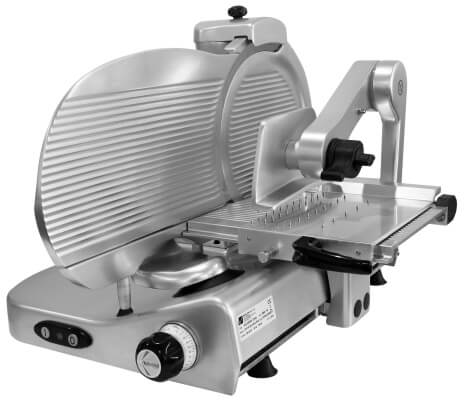If you are after manual or automatic commercial meat slicers, we stock a large range of quality meat slicers, food slicers, Prosciutto slicers Ham Slicer and cheese slicers that will suit your needs and budget. We stock the following types of slicers that cover a suite of operations: belt-driven, gear-driven, vertical, semi-automatic, fully automatic, and vintage meat slicers.
Why Every Food Business Needs a Commercial Meat Slicer
There are a wide variety of reasons to have a commercial meat slicer in your kitchen. Ensuring efficiency, speed, and output consistency, a good meat slicer can be a game-changer for your food business. With this innovative equipment, you can prepare meat, cheese, and vegetable delicacies with finesse and precision. An it’s a great time saver too! You can get tasks done in seconds, which would otherwise take minutes or even hours. Think of all the personalised platters you can delight your customer with, owing to the accuracy and seamless output delivery that a meat slicer promises. Needless to say, it’ll work wonders for your food presentation and visual appeal.
How to Choose the Best Commercial Meat Slicer for Your Needs?
On the lookout for the right commercial meat slicer? Make sure you factor in the volume of your business and type of slicing requirements. If your kitchen entails rigorous mincing and slicing, it’s wise to invest in a heavy-duty slicer with powerful motors and one that operates a continuously. The meat slicer should come equipped with an accurate blade adjustment feature. This helps to manage various thicknesses for a wide variety of items on the menu.
Slicing involves an element of risk, hence it’s essential to invest in models with non-slip feet, blade guards, and auto shut down features. Do not forget to consider the materials used in making the slicer. Stainless steel provides longevity and is easier to clean. Go for slicers with detachable parts that ease maintenance. Brice Australia offers reliable warranties and after-sales support that’ll significantly save you downtime.
Commercial Meat Slicers vs. Home Meat Slicers
If your regular activity involves bulk slicing and heavy usage, a commercial meat slicer makes most sense for you. Home slicers, on the other hand, are best relegated for low-scale use at homes. A commercial slicer is usually powered by a heavy-duty motor and super-efficient blade that can handle prolonged working time without over-heating. The use of durable materials like stainless steel ensures it can withstand rigorous cleaning regimes in a commercial kitchen. Commercial slicers often boast of cutting-edge features that help operators adjust slicing thickness and turn on essential safety mechanisms. In contrast, home slicers often use lightweight materials, which may not be quite effective for repetitive use.
Manual, Semi-Automatic, Fully Automatic and Commercial Meat Slicers
Our commercial meat slicer has standard features, including inbuilt sharpening devices, robust construction for easy cleaning and safety features to ensure safe and efficient operation.
Brice Commercial Meat Slicer will carefully slice and stack the product allowing you to continue working on other tasks. For those who want to maintain control over their slicing, our manual meat slicers will allow you to customise each slice to ensure tailor-made precision.
For those wanting to add the traditional feel and theatre to slicing, we have the vintage flywheel slicer and stand available in various colours to suit your look.
Commercial Meat Slicer Australia
We stock some of the best meat slicers and cheese slicers from reputable European manufacturers. With high-performance motors and rigid construction, you will be pleased to know that you are investing in commercial meat slicers Australia from a company in Australia that has been supporting Australia’s food and hospitality industry for over 80 years.
Get the best deals on Meat Cutters, Meat Slicers and Ham Slicers. We service Australia-wide, including Melbourne, Sydney, Brisbane, Adelaide, Canberra & Perth.

 0
0

 1300 664 880
1300 664 880 





























 1300 664 880
1300 664 880